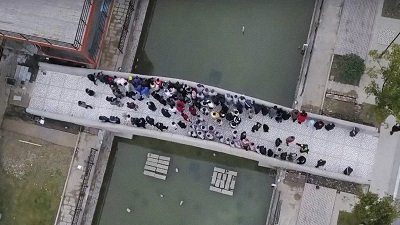 Thursday, April 25, 2024
Thursday, April 25, 2024  Thursday, April 25, 2024
Thursday, April 25, 2024 
As blogged on FastCompany.com, according to a team at Tsinghua University’s School of Architecture, led by professor Xu Weiguo, the world’s longest 3D-printed bridge actually has its roots in the ancient world.
Their 86-foot-long, 11-foot-wide bridge was inspired by the Anji Bridge(also called the Zhaozhou Bridge), the oldest open-spandrel stone segmental arc bridge in the world. Built by craftsman Li Chun during the Sui dynasty over a decade-long period beginning in AD 605, the surprisingly modern-looking, 123-foot-long bridge had been in use ever since it was built, although “its ornamental posts and railings have had to be replaced every 300 to 500 years.”
The nearly 1,500-year-old Anji–which means “safe crossing”–was built out of 28 curved limestone slabs, assembled together with iron dovetails. The Tsinghua team’s bridge, on the other hand, uses exclusively 3D-printed concrete. Located in the industrial and creative center of the Baoshan district, in Shanghai, it looks organic and biological, almost as if the concrete were fabric waving with the wind. The bridge isn’t a typical concrete form reinforced with steel. Instead, it was printed entirely out of a special polyethylene fiber concrete, which requires a specific printer flow rate and a certain amount of drying time to ensure stability over the decades. That’s why the team created its own robotic arm-powered injection system–and software to control its path and material pumping rate–that let them better control the specialized material.
While the engineers made sure they had a solid bridge by carefully controlling both the construction process and the material composition, 3D printing is still pretty much uncharted waters when it comes to long term durability. So it remains to be seen if this new bridge will last for more than a millennium, as the Anji bridge has. In fact, this is exactly what Weiguo’s team wants to find out. Their project is part public work, part experiment. It’s meant to test the validity of 3D printing for such structures, thanks to a sponsorship by Zoina Land Joint Research Center for Digital Architecture (JCDA) and the investment company Wisdom Global Capital in Shanghai. “It will promote the transformation and upgrading of China’s construction industry,” the university explains in a release.
Keep reading this blog on FastCompany.com
Watch the video and learn more about Construction Links Network – the peer-to-peer network sharing platform for the construction, building and design community.
Ideal for YOUR Press Releases | Project Updates | New Appointments | Awards & Milestones | Company News | New Products/Services | Brochures | Videos | Infographics | Blog Sharing | Events and More